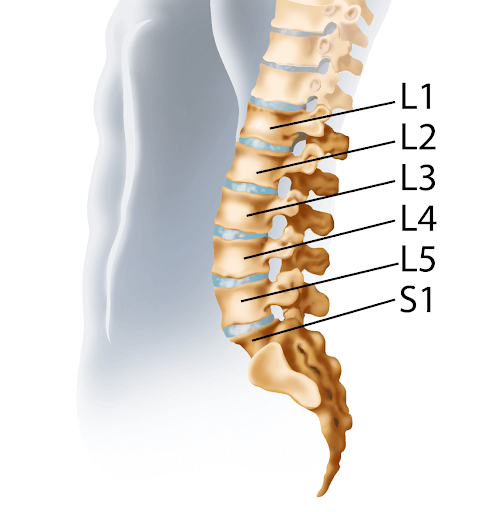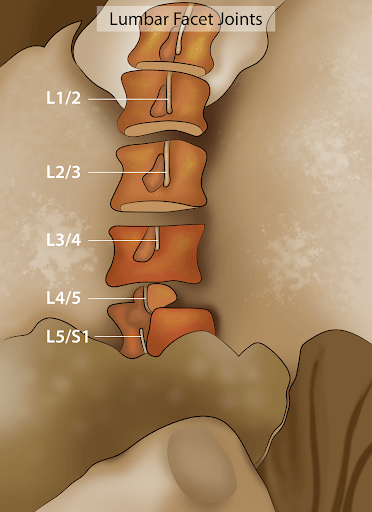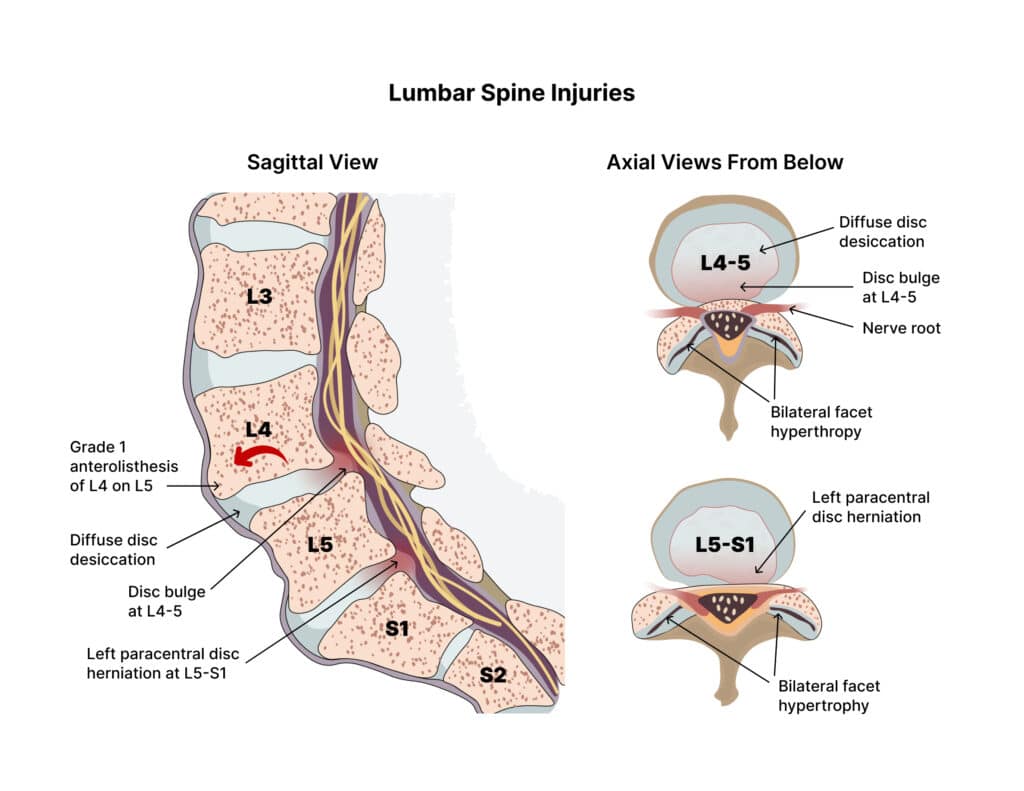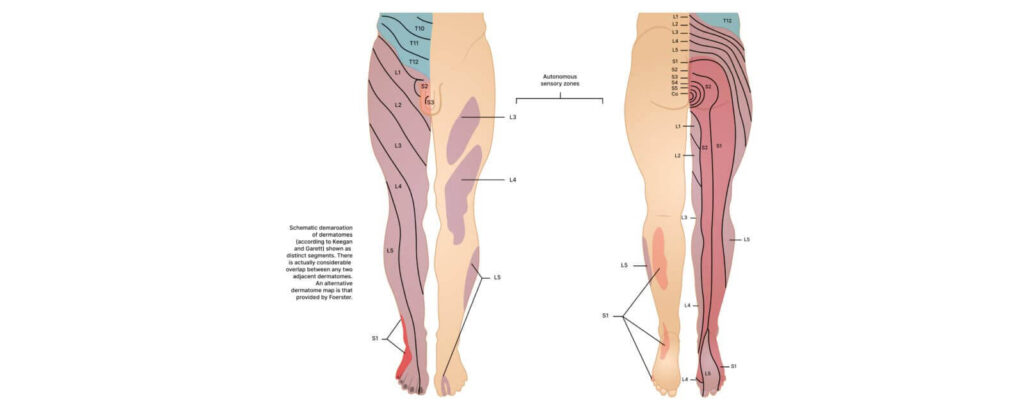The L5 S1 joint, or the lumbosacral joint, is a critical joint. It lies between the lumbar segment of the spine and the auricular processes of the sacrum. The L5-S1 joint plays a vital role in transmitting the weight of the body via the sacrum and ilium downwards. The weight is distributed to the femur while standing, and to the ischial tuberosities while sitting.
In this post, we’ll discuss the L5 S1 joint in detail, including the pathologies involving it and its associated treatment.
A Closer Look At The L5 S1, or Lumbosacral Joint
The L5 S1 joint (or the lumbosacral joint) is a combination of the fifth lumbar vertebra and the first sacral vertebra. It is an important joining that connects the trunk to the lower extremities.


Behind The Name
A typical vertebra has a vertebral body and vertebral arch. They enclose the vertebral foramen, which encases the spinal cord. Seven processes come from each vertebra.
These are the two superior articular processes, two transverse processes, two inferior articular processes, and a spinous process. Each of these processes functions as joint facets with adjacent vertebrae. These processes are also where muscles attach and originate from.
The L 5 S1 is a special motion segment that has certain kinematic characteristics compared with the higher lumbar segments. This leads to very unique degenerative conditions due to the additional stresses on this joint. This joint is reinforced by the iliolumbar and lumbosacral ligaments.

The rest of the vertebrae of the spine include
- Cervical Spine: The seven cervical spines are numbered C1 – C7 and are divided into two segments; the craniocervical junction and the subaxial spine.
- Thoracic Spine: The twelve thoracic vertebrae are numbered from T1 – T12. The last two form floating ribs and are mobile.
- Lumbar Spine: The five lumbar spines are numbered L1 – L5. The last lumbar vertebra forms an important motion segment with the first sacral joint.
- Sacrum: The five sacral vertebrae are fused and numbered S1 – S5. The fused bones form an inverted triangular bone that is concave in the front and convex at the back.
- Coccyx: The coccyx has fused vertebrae as well and are numbered from Co1 – Co4.
The Spinal Anatomy
The anatomy of the L5 S1 segment is very characteristic. Because this joint transmits weight, it experiences plenty of stress; repetitive bending and heavy lifting add to the stress on this joint. The joint’s components are listed below.

- L5 and S1 Vertebrae (L5, S1): The fifth lumbar and the first sacral vertebra. They are located at a slight slope and angle. Forward translation of the lumbar vertebrae affects the slope and the angle. This is why an incorrect posture can increase the stress on the joint.
- L5 and S1 Intervertebral Disc: The intervertebral disc between the L5 and S1.
- L5 Spinal Nerve (L5 Dermatome, L5 Myotome): The spinal nerves exiting from this joint supply the L5 (skin segments) dermatome and the L5 (muscle segments) myotome. These nerves supply the skin and muscles all the way down to the toes.

Its Function
Discuss how the L5 S1 segment works for the rest of the spine and the whole body. Note how it behaves when walking or doing some activities
Common Health Problems Originating From L5 S1
The most common conditions affecting the L5 S1 spinal joint segment are listed below.
Intervertebral Disc-Related Problems
The first set of conditions affecting the lumbosacral joint involves the intervertebral disc. These include:
- Degenerative Disc Disease: Lumbar degenerative disc disease occurs with age. Occupational roles such as heavy lifting or repetitive forceful bending contribute to the degeneration of the disc over time. This leads to the fragmentation of the disc.
- Bulging Disc: The degenerated disc may bulge out of its location, namely the intervertebral space. This bulging disc narrows the spinal canal, leading to compression of the spinal nerves and of the spine itself.
- Herniated Disc: Over time, the nucleus pulposus of the disc completely herniates into the spinal canal, leading to spinal stenosis. The herniated disc compresses the spine and the nerves exiting the spinal canal.
Facet Joint Pain
Facet joint syndrome is a condition specifically occurring in the lumbosacral joint. It occurs due to repetitive stress and low-level trauma that accumulates. It leads to inflammation and stretching of the joint capsule. This leads to lower back pain, encompassing the flank, hip, and thigh.
Joint-Related Problems
Various conditions affect the vertebrae and the involved joints. They include:
- Osteoarthritis: This is the inflammation of the lumbar vertebrae due to age and repetitive stress. Because of this inflammation, bony spurs are formed, which can narrow the spinal canal and compress the nerves and spine.
- Spondylolysis: This is a defect or fracture of the pars interarticularis of the vertebral arch. It occurs due to stress and is very common in the lumbar spine. It can cause back pain and is commonly found in adolescents.
- Spondylolisthesis: This is the forward translation of the L5 over the S1. The main cause is due to the spondylosis of the L5 or a stress injury due to repetitive bending or motion. The degree of the slip determines the extent of the symptoms.
Nerve-Related Problems
Any inflammation of the spinal nerves or the spine can cause nerve-related problems. These include:
- Sciatica: Compression of the spinal nerves emerging from the L5 S1 joint segment. The nerve roots in the lower back become irritated due to lumbar disc herniation, degeneration of the vertebra, and narrowing of the foramen. This reduces the space for the nerves exiting the canal.
- Cauda Equina Syndrome: This is the compression of the lumbosacral nerve roots of the cauda equina.The cauda equina is made of a bundle of spinal nerves and rootlets of L2- L5 nerve pairs, S1-S5 nerve pairs, and the coccygeal nerve.
This is considered a neurological emergency. Compression of these nerves leads to a syndrome that causes loss of bladder and bowel function.
Common Symptoms You Need To Watch Out For
Conditions involving the L5-S1 joint present with characteristic signs and symptoms. You need to watch out for them especially if you find them occurring with increasing frequency.
Joint-related Symptoms
- Localized Lower Back Pain: Dull, aching lower back pain is one of the first signs of lumbosacral joint conditions. Initially, it dissipates with rest. This pain can become sharper and more sporadic with time and can even occur when at rest.
- Lingering Dull Ache or Sharp Pain: The intensity of the pain can vary. It can be localized dull pain or sharp shooting pain that races down the leg.
- Affects Movement: This pain can worsen with movement because the lumbosacral joint is restricted either due to disc compression, bulging, bony spurs, or nerve impingement. Forcing movement of the restricted segment worsens the pain which further restricts motion.
Nerve-related Symptoms
- Sharp Pain from Inflamed Nerve: If a spinal nerve is affected, then the pain can be sharp, shooting, burning, or radiating throughout the areas of the back and leg connected to the very same nerve.
- Weakness and Numbness that can be Felt on the Foot or Toes: Since the spinal nerves are also responsible for the sensory and motor function of the lower extremities, any inflammation of the spinal nerve can cause weakness of the muscles and tingling or numbness in the skin.
- Pain in the Groin Area and Loss of Control of Bowel Movements: The spinal nerves of the lumbosacral joint supply the groin, bladder, and anal sphincter. When the L5 S1 joint is affected, which alters the function of these spinal nerves, this may lead to a loss of bowel or bladder control.
How Problems In The Lumbosacral Joint Are Diagnosed
Imaging is usually used to diagnose problems in the lumbosacral joint. Other tests are also used to check the nerves. The diagnostic tests used for conditions of the L5 S1 joint are listed below.
- X-ray: X-rays are simple and easily available. They can reveal gross abnormalities of the bone-like fractures of the joint, disc space narrowing, and osteo-degenerative changes such as bony spurs.
- CT Scan: A CT scan may be recommended if there are injuries, fractures, suspicion of an abscess, or infection. However, a CT scan cannot visualize soft tissue or tumors.
- MRI: An MRI is the best test to visualize not just the lumbosacral joint but the surrounding muscles, ligaments, and other soft tissues like the disc. It can identify any disc narrowing and the cause. It is also used to grade any spondylolisthesis which can help determine if surgery is needed or not.
- Myelogram: This is a combination of a CT scan with contrast dye to visualize the spinal column, the nerves, and the vertebrae. It is usually used in patients who have contraindications for MRI. It provides detailed images of the spinal canal.
- EMG: An EMG is a specific test that tests the muscles and nerves via electrical stimulation. This is usually done to test the level of impingement and the extent of the involvement of the spinal nerves if there is spinal stenosis.
Common Treatment Options
There are many treatment options available depending on the pathology affecting the L5 S1 joint. They are listed below and discussed in detail.
Non-Surgical Treatments
Non-surgical treatments are the first step in treating conditions affecting the L5 S1 joint. They form conservative management and include the following:
- Medications: One of the symptoms commonly associated with conditions involving the L5-S1 joint is pain.
Analgesics or pain medications are usually used to alleviate the pain. This includes NSAIDs (nonsteroidal anti-inflammatory drugs) and acetaminophen, and when the pain is severe, opiates are options as well. If there is radicular or nerve pain due to lumbosacral radiculopathy, then neuroleptic medications like diazepam are also used.
BUT these medications are designed for short-term use only and should not be abused or taken at high doses for long duration of time (>2 weeks)
- Physical Therapy: Physical therapy is a non-pharmacological therapy. In people with facet joint pain involving the LS S1 and sacral joint dysfunction, physical therapy has proven to be helpful. This involves focused stretching which must be guided by a trained physical therapist. This relaxes the tense ligaments and muscles of the joint.
- Chiropractic Adjustment/Manipulation: The studies on chiropractic adjustment are equivocal. In patients with painful L5 S1, any pain caused by sciatica, neuritis, lumbalgia or radiculitis can be treated by chiropractic adjustment.
This includes manipulation through active and passive interventions, with therapeutic exercises being the most common. These manipulation techniques have to be done by trained and experienced therapists. - Self-Treatment: Patients with a condition involving the L5 S1 can self-treat using a belt liner to support the lower spine while seated, heating pads to relieve back pain, and exercises to correct posture. The exercises ease the stress on the lumbosacral joint.
Surgical Treatments
Surgery is usually not necessary in the early stages of lumbosacral conditions.
However, if there is severe intervertebral disc disease or arthritis, or severe dysfunction that affects the quality of life, the following surgical interventions may be recommended:
- Microdiscectomy: A microdiscectomy is a procedure designated for lumbar disc herniations. It has become the gold standard for removing herniated lumbar discs. If it is a radiculopathy, then the nerve root that is affected is first identified. Fragmented parts of the disc are removed if they are impinging on a nerve through a smaller incision.
- Laminectomy: This is a procedure where the spinous process and the lamina of the L5 S1 joint are removed. This is mainly done to decompress the spinal canal. If there is a narrowing of the spinal canal due to degenerative stenosis, a fracture, tumors in the spinal canal, a spinal deformity, or an abscess, then laminectomy is a surgical alternative.
- Foraminotomy: A foraminotomy is a procedure to widen the intervertebral foramen by incising it. This is done when there is spinal stenosis due to arthritic bone spurs, cysts, or degeneration of the intervertebral discs.
- Facetectomy: A facetectomy is a surgery where one or both facets of the L5 S1 joint are removed if the spinal canal is narrowed due to facet joint syndrome, bone spurs, degenerative disc disease, or fractures.
- Lumbar Interbody Fusion: This is a surgical procedure performed when a person has degenerative disc disease. The surgeon fuses two vertebrae and removes the bulging or degenerated disc. He or she then replaces the disc with an implant.
This procedure is effective in stabilizing the painful segment, indirectly decompressing the impinged nerve, and correcting any deformity of the spine.
Injection Treatments
Some therapies involve injecting medication or radiotherapy. They are explained below:
- Lumbar Epidural Steroid Injections: When pain is intractable and cannot be controlled with pain medications, steroid injections are often given. These are a combination of steroids to reduce inflammation and anesthetics to control pain.
- Radiofrequency Ablation: Radiofrequency treatment is the treatment of choice for facet joint syndrome. Here, heat generated by radiation therapy is used to burn off the nerves that send pain signals. This temporarily relieves back pain.
The above injections, while quite common with patient dealing with sciatica or generalized low back pain, they can do more harm than good! There are links to additional information on why these are not ideal.
Possible alternative to lumbar epidural steroid injections and RFAs:
- Platelet Rich Plasma or Platelet Lysate – Learn more about this treatment here.
- Bone Marrow Concentrate – Learn more about this treatment here.
Understanding Your Body Well Is Vital
The LF S1 joint is a critical joint for weight transmission. With the increase in weight, the joint experiences more stress. At the first sign or symptom, it’s important to find out what’s amiss with the joint. Early diagnosis and timely treatment can prevent complications in the future.
To do that, you must understand your body and recognize early warning signs like tingling, pain, numbness, or inability to bend. If you’re experiencing any of these symptoms, call one of our board-certified doctors today.
Are you a Candidate?

